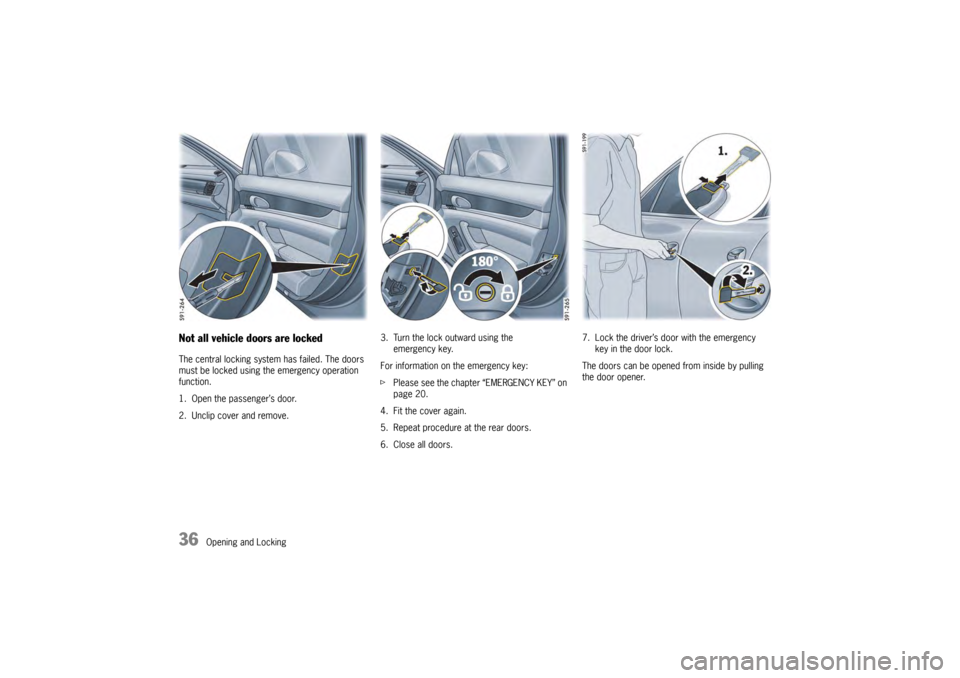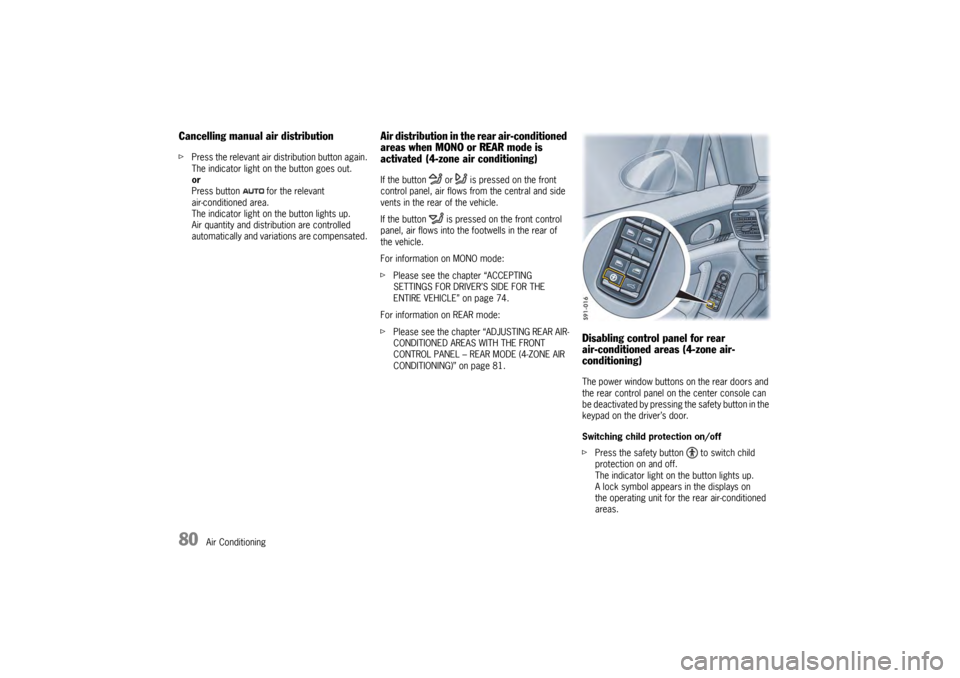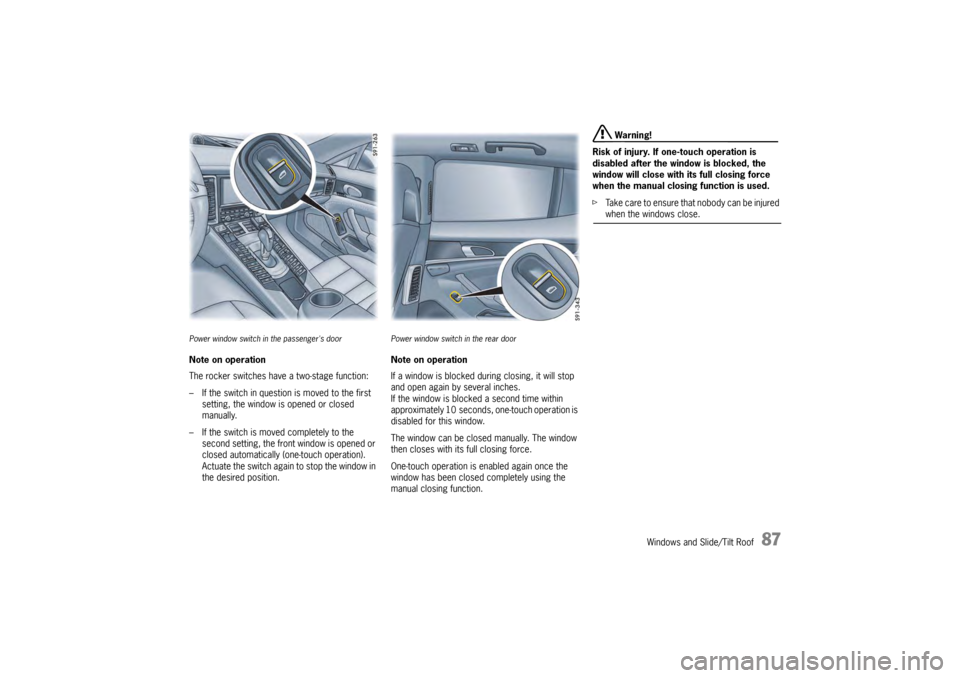2009 PORSCHE PANAMERA door lock
[x] Cancel search: door lockPage 36 of 343

34
Opening and Locking
1. Open the driver’s door.
2. Pull the release lever (
arrow).
The engine compartment lid is now unlocked. 3. Pull the unlocking handle (
arrow).
4. Open the engine compartment fully.
Closing1. Lower lid and let it fa ll into the lock. If
necessary, push the lid closed with the palm
of your hand in the area of the lock.
2. Check that the lid is en gaged correctly in the
lock and that the release lever is back in its
initial position.
When the vehicle is in motion, a message will
appear on the multi-function display in the
instrument panel if the lid is not closed properly.
Page 37 of 343

Opening and Locking
35
Malfunctions When Opening and
ClosingEmergency operation of tailgateIf the tailgate cannot be opened with the radio
remote control (e.g. if th e battery of the remote
control is dead), the emergency operation must
be performed:
1. Unlock and open the driver’s door with the car key.
2. Switch on the ignition within 10 seconds to prevent the alarm system from
triggering.
3. Press the central locking button on the front or rear center console.
The tailgate is now unlocked and can be
opened with the unlocking handle.
Only one door is unlockedOn the multi-function di splay in the instrument
panel, you can set different variants for locking
and unlocking the doors and tailgate. You can
open all doors irrespective of the setting made.
f Press button on the key twice within
2seconds.The vehicle cannot be unlockedThe remote control of the key may
– not function correctly due to radio waves (also
radio contact between remote control and
vehicle in the case of Porsche Entry & Drive),
– fail due to a fault,
– fail due to a flat key battery.
f Unlock the vehicle using the emergency key
in the door lock.
If the vehicle was unlocked using the
emergency key in the door lock, only the
driver’s door can be opened.
In order to prevent the alarm system from
being triggered, switch the ignition on
within 10 seconds of opening the door .
The vehicle cannot be lockedThis is recognizable by the fact that the
emergency flasher does not flash and there is no
locking noise.
The remote control of the key may
– not function correctly due to radio waves (also radio contact between remote control
and vehicle in the case of Porsche Entry &
Drive),
– fail due to a fault,
– fail due to a flat key battery.
f Lock the vehicle usin g the emergency key
in the door lock.
If the central locking system is defective,
operating the lock cylinder in the driver’s door will
lock all functioning lockin g elements of the central
locking system.
For information on lockin g the doors by means of
the emergency operation:
f Please see the chapter “NOT ALL VEHICLE
DOORS ARE LOCKED” on page 36.
f Have faults in the central locking system
repaired.
Please contact a qualified specialist workshop.
We recommend that you have an authorized
Porsche dealer to do this work as they have
trained workshop personnel and the necessary
parts and tools.
Page 38 of 343

36
Opening and Locking
Not all vehicle doors are locked The central locking system has failed. The doors
must be locked using the emergency operation
function.
1. Open the passenger’s door.
2. Unclip cover and remove.3. Turn the lock outward using the
emergency key.
For information on the emergency key:
f Please see the chapter “EMERGENCY KEY” on
page 20.
4. Fit the cover again.
5. Repeat procedure at the rear doors.
6. Close all doors. 7. Lock the driver’s door with the emergency
key in the door lock.
The doors can be opened from inside by pulling
the door opener.
Page 42 of 343

40
Seats, Mirrors and Steering Wheel
Driver's door memory buttons (driver memory or comfort
memory)Storing Vehicle SettingsDriver memoryThe current seat, exterior-mirror and steering
wheel settings are stored automatically on the car
key when the vehicle is locked.
Personal position settings for the driver’s seat,
exterior mirrors and the steering wheel can also
be stored in the person buttons and in the
driver’s door and retrieved at any time by pressing
the buttons.
Passenger's door memory buttons (comfort memory)Comfort memoryOn vehicles with the comfort memory package,
different vehicle settings, such as the multi-
function display, are stored on the car key and the
person buttons and in the driver’s door in
addition to the driver memory settings.
Personal position settings for the passenger seat
can be stored on the person buttons and in
the passenger’s door.
The passenger seat settings are not stored on the
car key.
Warning!
Risk of crushing due to uncontrolled
activation of settings.
f Do not activate the comfort memory button if
there is any risk of the seat crushing the
occupant.
f Cancel automatic adjustment by pressing any
of the seat adjustment buttons.
f Do not leave children in the vehicle unattended,
since they may depress the comfort setting
button and crush themselves or another occupant.
Page 50 of 343

48
Seats, Mirrors and Steering Wheel Danger!
To provide optimal occupant protection, air
bags must inflate at very high speed. If you
are not wearing your safety belt or are too
close to the air bag when it is deployed,
inflating air bags can result in serious
personal injury or death.
f Make sure there are no people, animals or
objects between the driver or passenger and
the area into which the air bags inflate.
f Sit back as far from the dashboard or steering
wheel as is practical, while still maintaining full
vehicle control.
f Always hold the steering wheel by the outer
rim. Never rest your hands on the air bag
panel.
f Always fasten seat belts because triggering
of the air bag system depends on the force
and angle of impact.
f Do not transport heavy objects on or in front of
the passenger seat. These could impair the
function of the air bags, the seat belts, and
occupant sensing.
f Do not hang objects (e. g., jackets, coats,
coat hangers) over the backrest. f
Always keep the lid of the door storage
compartment closed. Objects must not
protrude out of the door storage
compartment.
f Do not add any additional coverings or stickers
to the steering wheel or in the area of the
passenger air bag, side air bags, knee air
bags, and head air bags. Doing so may
adversely affect the functioning of the air bag
system or cause harm to the occupants if the
air bag system should deploy.
f No objects should be placed over or near the
air bag on the instrument panel, because any
such objects could cause harm if the vehicle is
in a crash severe enough to cause the air bag
to inflate.
f Do not modify the seat coverings, since such
changes can block the seat-mounted side air
bag. Do not attach additional cushions,
protective coverings, or pillows to the
passenger's seat. Do not affix things to the
passenger's seat or cover it with other
materials. Do not cover the back of the
backrest. Do not make changes to the
passenger's seat, the cushion or foam, the
occupant sensor, and to the seat base frame.
f No changes must be made to the wiring or
components of the air bag system.
f Do not install any wiring for electrical
accessory equipment in the vicinity of the air
bag wiring harnesses. Doing so may disable the air bag system or cause inadvertent
inflation.
f If the warning light comes on, the air bag
system should be repaired immediately by
your authorized Porsche dealer.
f Always keep feet in the footwell while driving.
Do not put feet on the dashboard or the seat
area. Do not lean against the inside of the door
or outside the window while the vehicle is
moving.
f Using accessories not approved by Porsche
can cause the occupant sensing to be
impaired.
f Do not squeeze objects, such as the fire
extinguisher, or first aid kit under the seat.
f Only have seats removed and installed by an
authorized Porsche dealer so that occupant
sensing components will not be damaged.
f Give your passenger all of the information in
this chapter.
Note
Air bag components (e.g. steering wheel, seats)
may be disassembled only by an authorized
Porsche dealer.
f When disposing of a used air bag unit, our
safety instructions must be followed. These
instructions can be obtained at any authorized
Porsche dealer.
Page 61 of 343

Seats, Mirrors and Steering Wheel
59
If the electrical adjustment facility fails
f Adjust the mirror by pressing on the
mirror face.Folding in exterior mirrorsfPress button D.
Both exterior mirrors fold in automatically.
If the electrical adjustment facility fails
f Fold in mirrors manually.Folding out exterior mirrorsfPress button D.
Both exterior mirrors unfold automatically.
Folding exterior mirrors in and out
automaticallyThe exterior-mirrors can be folded in automatically
after the vehicle is locked.
Folding exterior mirrors in automatically
f Press and hold the button on the car key for
at least 1 second.
or
On vehicles with Porsche Entry & Drive, press
and hold the locking button in the handle on the
driver’s door for at least 1 second.
The exterior mirrors fold in.
Folding exterior mirr ors out automatically
f Switch on ignition.
The exterior mirrors fold out.
Note
The exterior mirrors do not fold out automatically
after the ignition is switch ed on if they were folded
in manually using the button D.
If the electrical adj ustment facility fails
f Unfold mirrors manually.
Storing exterior mirror settingsOn vehicles with driver or comfort memory,
individual exterior mirror settings can be stored on
the person buttons on the driver’s side and on the
car key.
For further information on retrieving and storing
vehicle settings:
f Please see the chapter “STORING VEHICLE
SETTINGS” on page 40.Exterior mirror heatingThe exterior mirror heating is activated
automatically when the heated rear window is
switched on while the engine is running.
For information on switch ing on the heated rear
window:
f Please see the chapter “HEATED REAR
WINDOW/EXTERIOR MIRROR HEATING” on
page 84.
Page 82 of 343

80
Air Conditioning
Cancelling manual air distributionfPress the relevant air distribution button again.
The indicator light on the button goes out.
or
Press button for the relevant
air-conditioned area.
The indicator light on the button lights up.
Air quantity and distribution are controlled
automatically and variations are compensated.
Air distribution in the rear air-conditioned
areas when MONO or REAR mode is
activated (4-zone air conditioning)If the button or is pressed on the front
control panel, air flows from the central and side
vents in the rear of the vehicle.
If the button is pressed on the front control
panel, air flows into the footwells in the rear of
the vehicle.
For information on MONO mode:
fPlease see the chapter “ACCEPTING
SETTINGS FOR DRIVER’S SIDE FOR THE
ENTIRE VEHICLE” on page 74.
For information on REAR mode:
f Please see the chapter “ADJUSTING REAR AIR-
CONDITIONED AREAS WITH THE FRONT
CONTROL PANEL – REAR MODE (4-ZONE AIR
CONDITIONING)” on page 81.
Disabling control panel for rear
air-conditioned areas (4-zone air-
conditioning)The power window buttons on the rear doors and
the rear control panel on the center console can
be deactivated by pressing the safety button in the
keypad on the driver’s door.
Switching child protection on/off
fPress the safety button to switch child
protection on and off.
The indicator light on the button lights up.
A lock symbol appears in the displays on
the operating unit for the rear air-conditioned
areas.
Page 89 of 343

Windows and Slide/Tilt Roof
87
Power window switch in the passenger's doorNote on operation
The rocker switches have a two-stage function:
– If the switch in question is moved to the first
setting, the window is opened or closed
manually.
– If the switch is moved completely to the second setting, the front window is opened or
closed automatically (one-touch operation).
Actuate the switch again to stop the window in
the desired position.
Power window switch in the rear doorNote on operation
If a window is blocked during closing, it will stop
and open again by several inches.
If the window is blocked a second time within
approximately 10 seconds, one-touch operation is
disabled for this window.
The window can be closed manually. The window
then closes with its full closing force.
One-touch operation is enabled again once the
window has been closed completely using the
manual closing function.
Warning!
Risk of injury. If one-touch operation is
disabled after the wind ow is blocked, the
window will close with its full closing force
when the manual closing function is used.
f Take care to ensure that nobody can be injured when the windows close.